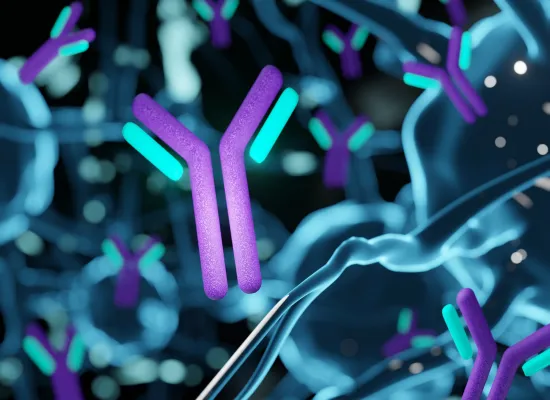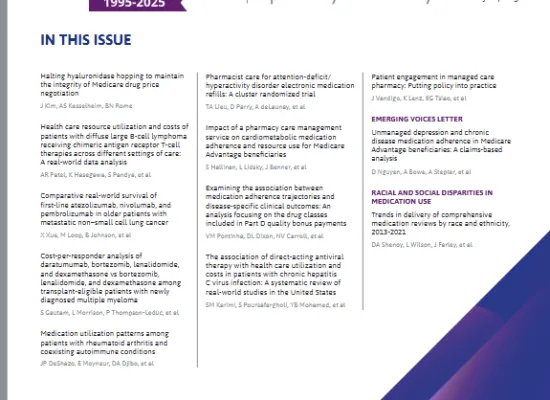
Anti-Discrimination Glossary
AMCP is committed to identifying how the field of managed care pharmacy can address health disparities. In order to engage in meaningful dialogue and identify concrete actions the profession can take, it is imperative to have a common language that promotes understanding.
To that end, AMCP has compiled a glossary of terms that will be useful for managed care pharmacists, other health care professionals, and stakeholders. It contains terminology to improve communications with providers, patients, caregivers, and colleagues. Among the terms defined are those that can be used to standardize data collection for race, ethnicity, and gender identity.
AMCP compiled the glossary from authoritative sources, including Seramount’s Diversity Best Practices program (excerpted with permission from their larger glossary). If a term is not from Seramount’s compiled glossary, the source is linked to within the definition. This resource is a living document that will be updated as language evolves.
As AMCP facilitates events and engages in research to identify patient-focused programs to address disparities in medication use, this glossary will serve as a resource and a foundation for dialogue. We also encourage health professionals to use this information in daily practice to implement or enhance their diversity, equity, and inclusion efforts.
| Access the pdf version of the glossary. |
A - F | G - L | M - R | S - Z
A-F
AAPI
All people of Asian, Asian American, or Pacific Islander ancestry who trace their origins to the countries, states, jurisdictions, and/or the diasporic communities of these geographic regions. (Source: Asian Pacific Institute on Gender-Based Violence)
Ableism
Discrimination against persons with mental and/or physical disabilities; social structures that favor able-bodied individuals. (Source: The National Multicultural Institute)
American Indian
A person having origins in any of the original peoples of North and South America (including Central America), and who maintains tribal affiliation or community attachment. (Source: U.S. Census Bureau)
In the United States the terms, American Indian, Indian, Native American, Native, or Indigenous are often used interchangeably. When addressing Native groups or people, use the terminology the members of that community use to describe themselves. (Source: Smithsonian National Museum of the American Indian)
Asian
A person having origins in any of the original peoples of the Far East, Southeast Asia, or the Indian sub-continent including, for example, Cambodia, China, India, Japan, Korea, Malaysia, Pakistan, the Philippine Islands, Thailand, and Vietnam. (Source: U.S. Census Bureau)
Belonging
The feeling of security and support when there is a sense of acceptance, inclusion, and identity for a member of a certain group or place. (Source: Huang, S; Society for Human Resource Management)
Bias
An inflexible positive or negative, conscious or unconscious belief about a particular category of people that leads to stereotyping. (Source: Thiederman, S)
BIPOC
An acronym for Black, Indigenous, and People of Color.
Bisexuality
Romantic and/or sexual attraction to people of more than one sex and/or gender, not necessarily at the same time, not necessarily in the same way, and not necessarily to the same degree. (Source: Ochs, R.)
Black or African American
A person having origins in any of the Black racial groups of Africa or of Australian Aboriginal ancestry. (Source: U.S. Census Bureau)
Cisgender
A term used to describe a person whose gender identity aligns with those typically associated with the sex assigned to them at birth. (Source: Human Rights Campaign)
Classism
Biased attitudes and beliefs that result in, and are used to justify, unfair treatment of individuals or groups because of their socioeconomic grouping. Classism can also be expressed as public policies and institutional practices that prevent people from breaking out of poverty rather than ensuring equal economic, social, and educational opportunity.
Colorism
Prejudice or discrimination against individuals with a dark skin tone, typically among people of the same ethnic or racial group. (Source: Canadian Race Relations Foundation)
Conscious Bias
Social stereotypes about certain groups of people that individuals form within their own conscious awareness. See also Bias and Unconscious Bias. (Source: UCSF, Office of Diversity & Outreach)
Cultural Competence
Refers to an individual’s or an organization’s knowledge and understanding of different cultures and perspectives. It’s a measure of an individual’s or a workforce’s ability to work with people of different nationalities, ethnicities, languages, and religions.
Cultural Intelligence (CQ)
The ability to adapt, relate, and work effectively across cultures. People with high CQ are not experts in every kind of culture. Instead, they have the skills to go into new environments with confidence, and to make informed judgments based on observations and evidence as opposed to stereotypes and biases. They recognize shared influences among particular groups.
Cultural Sensitivity
Being aware that cultural differences and similarities between people exist without assigning them a value.
Disability
Physical or mental impairment, the perception of a physical or mental impairment, or a history of having had a physical or mental impairment that substantially limits one or more major life activities. Replaces the term handicap or the handicapped, which does not reflect the individuality, equality, or dignity of people with disabilities.
Discrimination
Unfavorable or unfair treatment towards an individual or group based on their race, ethnicity, color, national origin or ancestry, religion, socioeconomic status, education, sex, marital status, parental status, veteran’s status, political affiliation, language, age, gender, physical or mental abilities, sexual orientation, or gender identity.
Diversity
Psychological, physical, and social differences that occur among any and all individuals, including but not limited to race, ethnicity, nationality, religion, socioeconomic status, education, marital status, language, age, gender, sexual orientation, mental or physical ability, and learning styles. A diverse group, community, or organization is one in which a variety of social and cultural characteristics exist.
Equality
Evenly distributed access to resources and opportunity necessary for a safe and healthy life; uniform distribution of access to ensure fairness.
Equity
The guarantee of fair treatment, access, opportunity, and advancement while at the same time striving to identify and eliminate barriers that have prevented the full participation of some groups. The principle of equity acknowledges that there are historically underserved and underrepresented populations and that fairness regarding these unbalanced conditions is needed to assist equality in the provision of effective opportunities to all groups.
Ethnicity
A social construct that divides people into smaller social groups based on characteristics such as values, behavioral patterns, language, political and economic interests, history, and ancestral geographical base.
G-L
Gay
A person who is emotionally, romantically or sexually attracted to members of the same gender. Men, women, and non-binary people may use this term to describe them- selves. (Source: Human Rights Campaign)
Gender
The socially constructed ideas about behavior, actions, and roles a particular sex performs.
Genderfluid
Describes a person who does not consistently adhere to one fixed gender and who may move among genders. (Source: PFLAG)
Gender Identity
A personal conception of one’s own gender; often in relation to a gender opposition between masculinity and femininity. Gender expression is how people externally communicate or perform their gender identity to others. (Source: National Multicultural Institute)
Hispanic
A term adopted in the United States in an attempt to group immigrants and their descendants whose countries of origin derive from Latin America. Hispanic is often used interchangeable with “Latino” or “Latina” despite the potential to convey slightly different connotations. These terms only refer to a person’s origin and history. A Hispanic/Latino/Latina person can be any race or color. (Source: Encyclopedia Britannica)
Implicit Bias
See Unconscious Bias
Inclusive Language
Words or phrases that include all potential audiences from any identity group. Inclusive language does not assume or connote the absence of any group. An example of gender-inclusive language is using “police officers” instead of “policemen.”
Inclusion
The act of creating environments in which any individual or group can be and feel welcomed, respected, supported, and valued to fully participate. An inclusive and welcoming climate embraces differences and offers respect in words and actions for all people.
Indigenous
Originating from a culture with ancient ties to the land in which a group resides. (See also American Indian)
Indígenas
A term Indigenous people in Spanish-speaking countries in the Americas use to describe themselves. (Source: Smithsonian National Museum of the American Indian)
Intersectionality
The interconnected nature of social categorizations such as race, class, and gender as they apply to a given individual or group, regarded as creating overlapping and interdependent systems of discrimination or disadvantage. (Source: Oxford English Dictionary)
Institutional Racism
Refers specifically to the ways in which institutional policies and practices create different outcomes for different racial groups. The institutional policies may never mention any racial group, but their effect is to create advantages for white people and oppression and disadvantage for people from groups classified as people of color. (Source: Potapchuk, Leiderman, Bivens, and Major)
Invisible Disability (Hidden Disability)
An umbrella term that captures a whole spectrum of hidden disabilities or challenges that are primarily neurological in nature. Invisible disability, or hidden disability, are defined as disabilities that are not immediately apparent.
Latine
A gender-neutral form of the word Latino, created by LGBTQ+, gender non-binary, and feminist communities in Spanish-speaking countries. The objective of the term Latine is to remove gender from the Spanish word Latino, by replacing it with the gender-neutral Spanish letter E. (Source: Call Me Latine)
Latino/a
A person of Cuban, Mexican, Chicano, Puerto Rican, South or Central American, or other Spanish culture or origin, regardless of race. (See Hispanic and Latine)
Lesbian
A woman who is emotionally, romantically or sexually attracted to other women. Women and non-binary people may use this term to describe themselves. (Source: Human Rights Campaign)
LGBTQ+
An acronym for lesbian, gay, bisexual, transgender and queer with a plus sign (+) to recognize the limitless sexual orientations and gender identities used by members of the community. (Source: Human Rights Campaign)
M-R
Marginalization
The placement of minority groups and cultures outside mainstream society. All that varies from the norm of the dominant culture is devalued and at times perceived as deviant and regressive.
Neurodiversity
Refers to the variation in the human brain regarding sociability, learning, attention, mood, and other mental functions.
Non-binary
An adjective describing a person who does not identify exclusively as a man or a woman. Non-binary people may identify as being both a man and a woman, somewhere in between, or as falling completely outside these categories.
Pacific Islander
A person having origins in any of the original peoples of Hawaii, Guam, Samoa, or other Pacific Islands. (Source: U.S. Census Bureau)
Pansexuality
A term reflective of those who feel they are sexually, emotionally, and spiritually capable of falling in love with all genders.
People/Person of Color
A term used to encompass people of diverse ethnic and cultural backgrounds and acknowledge how each of these individual communities distinctly experiences racism: Asian, Black, Hispanic/Latinx/Latine, Indigenous, Middle Eastern, Pacific Islander, and multiracial. (Source: DoSomething.org)
People/Person-First Language
Emphasizes the individuality, equality, and dignity of people with disabilities. Rather than defining people primarily by their disability, people-first language conveys respect by emphasizing the fact that people with disabilities are first and foremost just that — people.
People/Person with Disabilities
Refers to individuals with a disability. This term utilizes person-first language, which posits that a person isn’t a disability, condition or diagnosis, but rather that a person has a disability, condition or diagnosis. Replaces the terms handicap, the handicapped, the disabled, wheelchair-bound, and cripple, which do not reflect the individuality, equality, or dignity of people with disabilities.
Queer
A term used to refer to people or culture of the lesbian, gay, bisexual, transgender community. The term was once perceived as derogatory but is now embraced by some members of the LGBTQ+ community.
Race
A social construct that artificially divides people into distinct groups based on characteristics such as physical appearance, ancestral heritage, cultural affiliation, cultural history, ethnic classification, or the political needs of a society at a given time.
Racial and Ethnic Identity
An individual’s awareness and experience of being a member of a racial and ethnic group; the racial and the ethnic categories that an individual chooses to describe him or herself based on such factors as biological heritage, physical appearance, cultural affiliation, early socialization, and personal experience.
Racial Equity
A process of eliminating racial disparities and improving outcomes for everyone. It is the intentional and continual practice of changing policies, practices, systems, and structures by prioritizing measurable change in the lives of people of color. (Source: Race Forward)
Racism
The belief that humans may be divided into separate and exclusive biological entities called “races”; that there is a causal link between inherited physical traits and traits of personality, intellect, morality, and other cultural and behavioral features; and that some races are innately superior to others. See also Institutional Racism. (Source: Encyclopedia Britannica)
S-Z
Sex
System of classification based on biological and physical differences, such as primary and secondary sexual characteristics. Differentiated from gender, which is based on the social construction and expectations of the categories “men” and “women.”
Sexual Orientation
The direction of one’s sexual attraction toward the same gender, opposite gender, or other genders. It is on a continuum and not necessarily a set of absolute categories.
Tolerance
Acceptance of and open-mindedness toward different practices, attitudes, and cultures; does not necessarily imply agreement with those differences.
Transgender
An individual whose gender identity differs from the societal expectations of their physical sex. Transgender or “trans” does not imply any form of sexual orientation. Cisgender is a gender identity where an individual’s self-perception of their gender matches their sex. For example, a cisgendered female is a female with a female identity.
Two-Spirit
A term used within some American Indian (AI) and Alaska Native (AN) communities to refer to a person who identifies as having both a male and a female essence or spirit. The term, which was created in 1990 by a group of AI/AN activists at an annual Native LGBTQ conference, encompasses sexual, cultural, gender, and spiritual identities, and provides unifying, positive, and encouraging language that emphasizes reconnecting with tribal traditions.
Unconscious Bias (also known as implicit bias):
Social stereotypes about certain groups of people that individuals form outside their own conscious awareness. Everyone holds unconscious beliefs about various social and identity groups, and these biases stem from one’s tendency to organize social worlds by categorizing. See also Bias and Conscious Bias. (Source: UCSF, Office of Diversity & Outreach)
Underrepresented Groups (URG)
A group that is less represented in one subset (e.g., employees in a particular sector, such as women in STEM) than in the general population. This can refer to gender, race/ethnicity, physical or mental ability, LGBTQ+ status, and many more. Replaces the term Underrepresented Minorities (URM), as minority groups will soon be the majority in the U.S. Underrepresented Groups is inclusive of LGBTQ+ individuals as well as Veterans and People with Disabilities.
Veteran
A person who served as an active member of the Armed Forces of the United States and was discharged or released under honorable circumstances. Armed Forces is defined as the Army, Navy, Marine Corps, Air Force, and Coast Guard, including all components thereof, and the National Guard.
White
A person having origins in any of the original peoples of Europe, the Middle East, or North Africa. (Source: U.S. Census Bureau) (There has been consideration by the federal government and others about potentially separating North African and Arab from the definition of White. Adjustments to this definition may be made in the future to reflect those changes, if implemented.)
Featured News & Resources
See Full CalendarAI Pre-Conference Program
AMCP Southwest Day of Education
News & Resources by Topic
AMCP offers a wide variety of educational opportunities, from events and webinars to online training.







